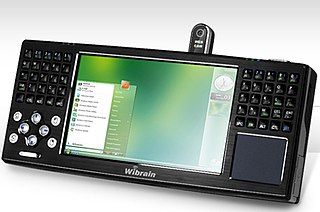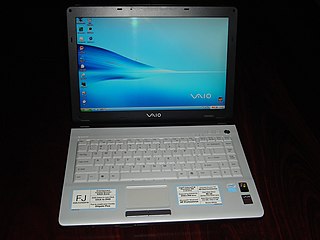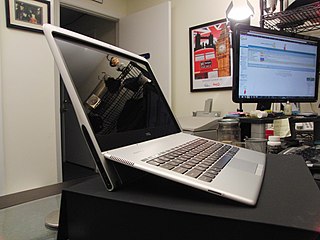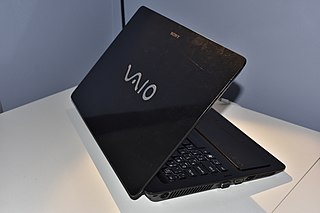Related Research Articles
VAIO Corporation is a Japanese manufacturer headquartered in Azumino, Nagano Prefecture that makes personal computers (laptops).

Alienware is an American computer hardware subsidiary of Dell. Their product range is dedicated to gaming computers which can be identified by their alien-themed designs. Alienware was founded in 1996 by Nelson Gonzalez and Alex Aguila. The development of the company is also associated with Frank Azor, Arthur Lewis, Joe Balerdi, and Michael S. Dell. The company's corporate headquarters is located in The Hammocks, Miami, Florida.

An ultra-mobile PC is a miniature version of a pen computer, a class of laptop whose specifications were launched by Microsoft and Intel in spring 2006. Sony had already made a first attempt in this direction in 2004 with its Vaio U series, which was only sold in Asia. UMPCs are generally smaller than subnotebooks, have a TFT display measuring (diagonally) about 12.7 to 17.8 centimetres, are operated like tablet PCs using a touchscreen or a stylus, and can also have a physical keyboard. There is no clear boundary between subnotebooks and ultra-mobile PCs, but UMPCs commonly have form factors other than the common clamshell laptop design, such as having small keys on either side of the screen, or having a slide-out keyboard.

The Sony Vaio FJ series is a 14.1 inch notebook designed for Windows XP and the FJ270, FJ290, FJ330,FJ370 models in particular, are designed for Windows Vista. The FJ Series uses only the Pentium M processors using the Sonoma platform of Intel Centrino.

Dell Vostro is a line of business-oriented laptop and desktop computers manufactured by Dell aimed at small businesses. From 2013–2015, the line was temporarily discontinued on some Dell websites but continued to be offered in other markets, such as Malaysia and India.

Adamo was a Dell slim luxury ultraportable subnotebook focused on design and mobility, intended to compete with Apple's MacBook Air laptop.

The Sony Vaio P series is a range of ultraportable subnotebook computers launched in January 2009.
Sony has used the Z model naming scheme for its high-end ultraportable notebook computers since 2000. Unlike other Sony models, the Z has always been manufactured in Japan or in the United States for some models. Sony has stated that production of the Z series will cease at the end of 2012.

The Vaio X series is a line of high-end ultraportable notebook computers from Sony introduced in September 2009, claiming to be the world's lightest notebook, at 655 grams ( ). It features an 11.1", 16:9, 1366x768 LED-lit LCD screen with built-in webcam, 2GB of DDR2 RAM, a choice of 64, 128 or 256 GB SSD, Intel Atom Z540 1.86 GHz or Z550 2.00 GHz, WWAN.
The Sony Vaio SR series was a line of consumer-grade notebook computers from Sony introduced in July/August 2008 to replace the Sony Vaio C series range, as a part of the Intel Centrino 2 launch. They are equipped with a 13.3" screen and weigh approximately 1.95kg, significantly lighter than the C series, similar to the non-premium carbon fiber models of the SZ, but significantly heavier than the Z Series.

The Vaio S series was a line of notebook computers from Sony introduced in summer 2004. They have been touted as business laptops, and their designs have focused on being thin and light. They also have features friendly to businesspeople, such as TPM chips, matte (anti-glare) displays, RAID SSDs, and extended sheet batteries, as well as continuing to include RJ-45 and VGA (D-Sub) connections.

The Vaio F series is Sony's current multimedia and gaming orientated laptop. Launched in January 2010, it replaced the Sony Vaio FW series. Like the preceding model, it features a 16.4" screen, but with Full HD 1920x1080 resolution, 240 Hz refresh rate, and LED backlight. The model came in two choices, 2D or 3D models. The 3D model is included with 3D glasses.
The Vaio AW series is a discontinued range of high-end multimedia laptop computers from Sony introduced in September 2008, replacing the AR Series. They feature an 18.4" 16:9 screen with 1680x945 or LED-backlit 1920x1080 (1080p) screen, NVidia GeForce 9300M GS 256MB or 9600M GT 512MB graphics, Blu-ray drive, Intel 5100AGN wireless chipset, Core 2 Duo P or T CPUs and a 1.3 megapixel webcam, optional RAID SSD storage and HDMI output.
Sony VAIO AR series was a range of high-end multimedia notebook computers from Sony introduced in June 2006 as the first laptop with integrated Blu-ray drive. It replaced the AX Series. It featured a 17" 16:10 widescreen LCD screen, with choice of 1440x900 or 1920x1200 resolutions. It was replaced by the AW series.
The Vaio Y series is a line of notebook computer from Sony introduced in January 2010. It is a netbook-inspired model designed for travel use: compared with the other 13.3" models in the Vaio range, the Y lacks an optical drive, and is heavier and cheaper than the premium Sony Vaio Z series, but lighter than the consumer-grade Sony Vaio S series, with better battery life than either, thanks to the use of CULV processors. The weight is 3.92lbs (1.78kg).
The Sony Vaio FZ series is a discontinued model of laptop sold by Sony in 2007. It replaced the Sony Vaio FE series, featuring Intel Core 2 Duo rather than Core Duo CPU, and other improvements. It was criticised for the low-resolution 1280x800 15.4-inch screen, poor battery life and its 2.7 kg weight. It was, however, praised for its display quality and the inclusion of Blu-ray drives on more expensive models.
The Sony Vaio G series was a range of ultraportable subnotebook computers launched in 2007 with a 12.1" display.

The ThinkPad X series is a line of laptop computers and convertible tablets produced by Lenovo with less power than it's other counterparts. It was initially produced by IBM until 2005.

The HP Envy is a line of consumer-oriented high-end laptops, desktop computers and printers manufactured and sold by HP Inc. They started as a high-end version of the HP Pavilion line.
The Sony Vaio VGX series was a series of living room PCs created for Sony's Vaio line that were released from 2005 until 2008. The VGX series was aimed at consumers who wanted the flexibility of able to watch TV and have the functionality of a computer at the comfort of their living room. All models came built-in with an HDMI port, VHF/UHF output, S-Video, Optical Audio port, and a variation of Microsoft Windows with Media Center installed.